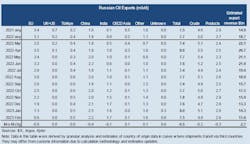IEA: Russia reroutes trade to sustain oil exports, revenues plunge
A year after its invasion of Ukraine, Russia is still shipping roughly the same amount of oil to world markets, but its revenues have taken a hit. According to the International Energy Agency (IEA), this shows that the G7 sanctions regime has been effective in undermining Russia’s ability to generate export revenue while at the same time not restricting the global supply of crude oil and products.
Recent tanker tracking data suggest that Moscow has managed to reroute most of the barrels previously destined for the European Union (EU) and US to new outlets in Asia, Africa, and the Middle East. In February, however, Russia earned $11.6 billion from oil sales of 7.5 million b/d (500,000 b/d less than in January), compared with $14.3 billion in January and nearly $20 billion a year before.
The dramatic shift in trade has seen Russian crude oil exports pivot from Europe to Asia’s top consumers: China and India. By February, shipments of Russian crude to Europe had declined by 2.1 million b/d year-on-year (y-o-y), while exports to India had increased by 1.6 million b/d and to China by 500,000 b/d.
Compared with January, Russian crude oil exports in February were 200,000 b/d lower. According to IEA data, confirmed shipments to China decreased by 300,000 b/d from January’s record-high but could end up higher once cargoes with no set destination find buyers. Exports to Europe eased by 200,000 b/d month-on-month (m-o-m), primarily due to the halt in flows to Poland on the 2-million b/d Druzhba pipeline. Turkish and Bulgarian refineries are still importing Russian seaborne crude.
A similar pattern is expected to develop on product trade flows, following enforcement of last month’s European products embargo, according to IEA.
In February, Russian product exports to Europe decreased by 550,000 b/d m-o-m and 1.7 million b/d y-o-y to 250,000 b/d. Moscow appears to be redirecting some of this volume to the Middle East (+190,000 b/d y-o-y), Türkiye (+230,000 b/d y-o-y), Asia (+310,000 b/d y-o-y), and Africa (+250,000 b/d y-o-y).
The Middle East was the first to emerge as a new outlet, snapping up cheap naphtha and fuel oil very quickly after the invasion. Türkiye as well as Asian countries started to show interest in the middle of 2022, with China, India and countries on the Malay Peninsula especially keen. With the imposition of the G7 price cap, Africa has stepped up to buy. Russian refined products exports to the region rose 140,000 b/d in February 2023 to reach 430,000 b/d, with the biggest increase in gasoil.
